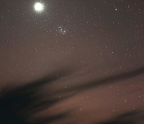Meade’s DSI-IV camera

DIGITAL IMAGING HAS BEEN part of amateur astronomy for more than three decades. It’s a sobering thought for those of us who’ve been there since the beginning. Over the years, Meade has introduced a number of astronomy cameras, but the newest — the DSI-IV — might be the best one yet. It all depends on your imaging interests.
The DSI-IV is a highly versatile camera capable of recording high-resolution video of the Moon and planets as well as quality long exposures of faint deep sky objects. It’s built around a cooled, 16-megapixel Panasonic CMOS detector with 3.8-micron-square pixels in a 4,640-by-3,506-pixel array. The sensor’s imaging area measures 17.6 by 13.3 mm, making it slightly smaller than the APS chips in today’s crop-sensor DSLR cameras.
For this review we borrowed a monochrome version of the DSI-IV from Meade. A one-shot colour version is also available for a little less money. The camera
You’re reading a preview, subscribe to read more.
Start your free 30 days



